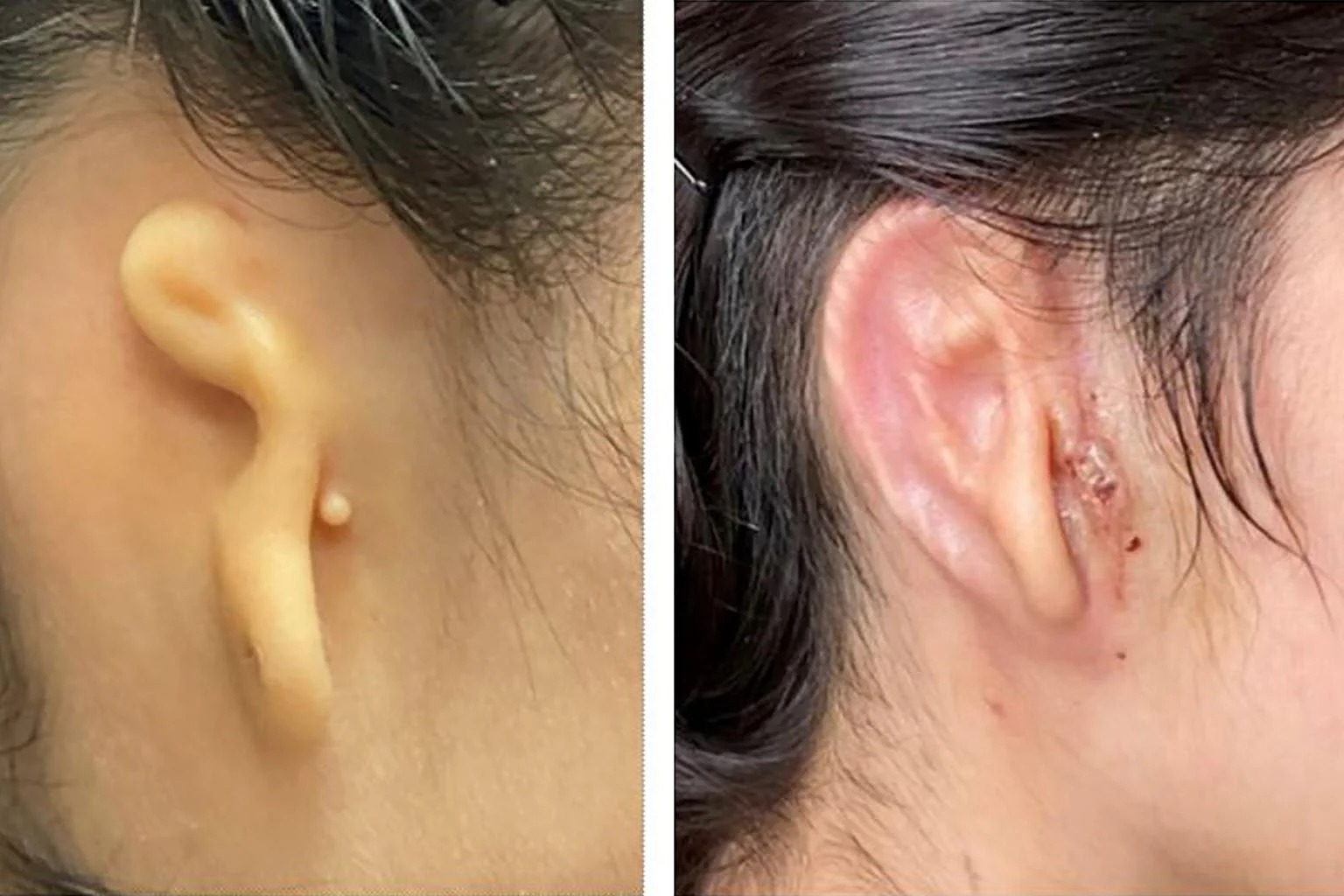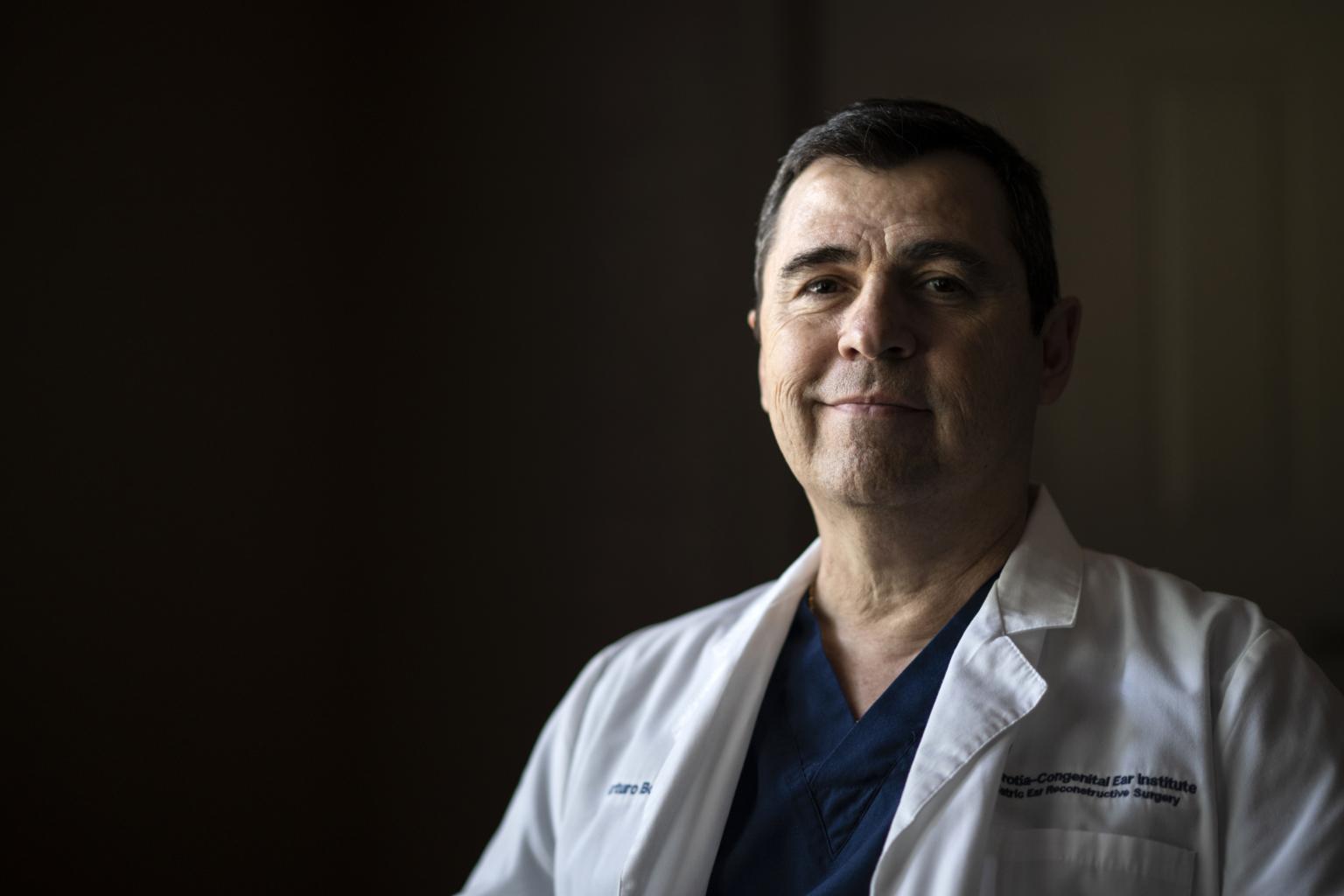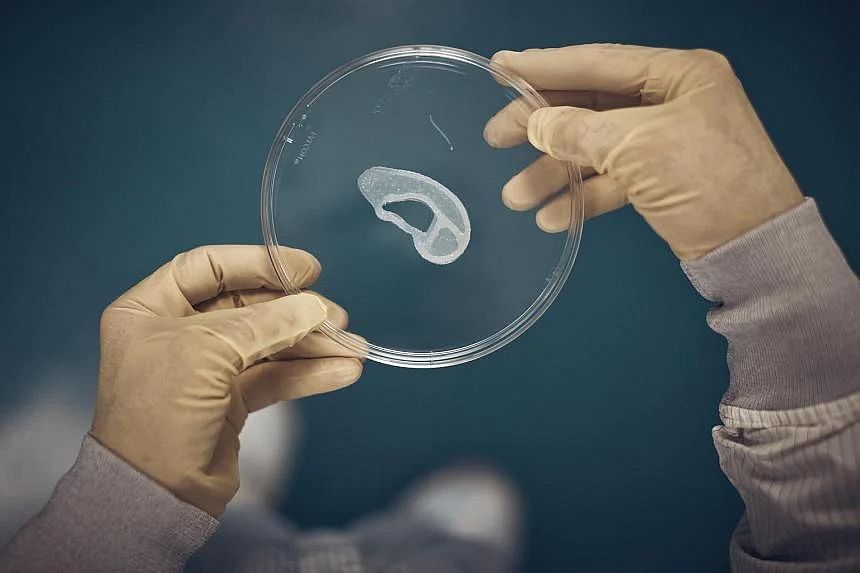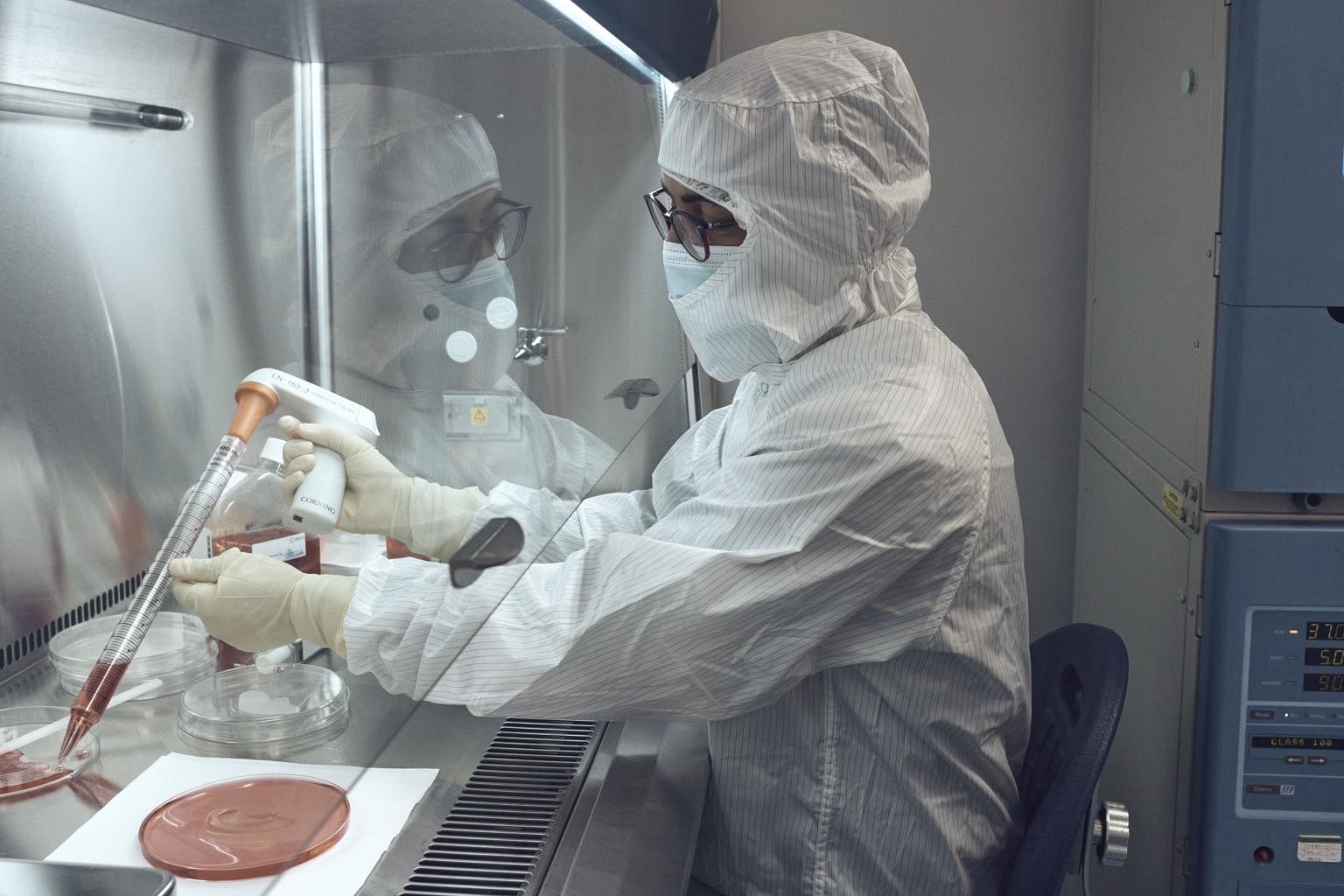Doctors transplant 3D printed ear made of human cells which looks and feels natural
Sign up now: Get ST's newsletters delivered to your inbox

A patient before surgery (left) and 30 days after a 3D printed ear implant operation.
PHOTO: NYTIMES
Follow topic:
NEW YORK (NYTIMES) - A 20-year-old woman who was born with a small and misshapen right ear has received a 3D printed ear implant made from her own cells, the manufacturer announced on Thursday (June 2).
Independent experts said the transplant, part of the first clinical trial of a successful medical application of this technology, was a stunning advance in the field of tissue engineering.
The new ear was printed in a shape that precisely matched the woman's left ear, according to 3DBio Therapeutics, a regenerative medicine company based in New York. The new ear, transplanted in March, will continue to regenerate cartilage tissue, giving it the look and feel of a natural ear, the company said.
"It's definitely a big deal," said Prof Adam Feinberg, an expert in biomedical engineering and materials science and engineering at Carnegie Mellon University. Prof Feinberg, who is not affiliated with 3DBio, is a co-founder of FluidForm, a regenerative medicine company that also uses 3D printing.
"It shows this technology is not an 'if' anymore, but a 'when'," he said.
The results of the woman's reconstructive surgery were announced by 3DBio in a news release. Citing proprietary concerns, the company has not publicly disclosed the technical details of the process, making it harder for outside experts to evaluate. The company said that federal regulators had reviewed the trial design and set strict manufacturing standards and that the data would be published in a medical journal when the study was complete.
The clinical trial, which includes 11 patients, is ongoing, and it is possible that the transplants could fail or bring unanticipated health complications. But since the cells originated from the patient's own tissue, the new ear is not likely to be rejected by the body, doctors and company officials said.
3DBio's success, seven years in the making, is one of several recent breakthroughs in the quest to improve organ and tissue transplants. In January, surgeons in Maryland transplanted a genetically modified pig's heart into a 57-year-old man with heart disease, extending his life by two months. Scientists are also developing techniques to extend the life of donor organs so they do not go to waste; Swiss doctors reported this week that a patient who received a human liver that had been preserved for three days was still healthy a year later.
United Therapeutics, the company that provided the genetically engineered pig for the heart procedure, is also experimenting with 3D printing to produce lungs for transplants, a spokesman said. And scientists from the Israel Institute of Technology reported last September that they had 3D printed a network of blood vessels, which would be necessary to supply blood to implanted tissues.
Companies have previously used 3D printing technology to produce custom-fit prosthetic limbs made of plastic and lightweight metals. But the ear implant, made from a tiny glob of cells harvested from the woman's misshapen ear, appears to be the first known example of a 3D printed implant made of living tissues.
The patient, who is from Mexico, was born with microtia, a rare birth defect that causes the auricle, or external part of the ear, to be small and malformed (it can also affect hearing in the ear).
With more research, company executives said, the technology could be used to make many other replacement body parts, including spinal discs, noses, knee menisci, rotator cuffs and reconstructive tissue for lumpectomies. Further down the road, they said, 3D printing could even produce far more complex vital organs, such as livers, kidneys and pancreases.
"This is so exciting, sometimes I have to temper myself a little bit," said Dr Arturo Bonilla, a paediatric ear reconstructive surgeon in San Antonio who performed the woman's implant surgery. The trial was funded by 3DBio Therapeutics, but Dr Bonilla does not have any financial stake in the company.
"If everything goes as planned, this will revolutionise the way this is done," he said.

Dr James Iatridis, who heads a spine bioengineering laboratory at Mount Sinai's Icahn School of Medicine, said that other 3D printed tissue implants were in the pipeline, but that he was unaware of any other products being tested in a clinical trial.
"The 3D ear implant is then a proof of concept to evaluate biocompatibility, and shape matching and shape retention, in living people," Dr Iatridis said.
Still, the external part of the ear is a relatively simple appendage that is more cosmetic than functional, said Prof Feinberg. He cautioned that the path towards solid organs, such as livers, kidneys, hearts and lungs, was still a long one.
"Just going from an ear to a spinal disc is a pretty big jump, but it's more realistic if you've got the ear," he said.
The 3D printing manufacturing process creates a solid, three-dimensional object from a digital model. The technology generally involves a computer-controlled printer depositing material in thin layers to create the precise shape of the object.
The new ear implant from 3DBio Therapeutics integrates several proprietary technologies, executives said, beginning with a method for turning a small sample of a patient's cells into billions of cells. The company's 3D printer uses a collagen-based "bio ink" that is safe in the body and that keeps all of the materials sterile.
All of the research and manufacturing takes place under one roof, in a new, unassuming brick building in Queens equipped with hygienic "clean rooms" that are staffed by masked technicians wearing bunny suit coveralls, gloves and bootees.
"It comes in as a biopsy from the patient, and it leaves a living ear," Dr Daniel Cohen, 3DBio's chief executive and co-founder, explained during a tour of the facility last week.
The patient who received the new ear was one of the first to have had a successful transplant as part of the clinical trial led by Dr Bonilla. (Trial volunteers are also being enrolled at Cedars-Sinai Medical Centre in Los Angeles.) The surgeon began by removing half of a gram of cartilage from the woman's microtia ear remnant. He shipped that, along with a 3D scan of her healthy ear, from San Antonio to the 3DBio building in Long Island City, Queens.

At the facility, the patient's chondrocytes - cells responsible for cartilage formation - were isolated from the tissue sample and grown in a proprietary slurry of nutrients, proliferating into billions of cells.
The living cells were then mixed with the company's collagen-based bio-ink, "like chocolate chips mixed into cookie dough ice cream", said Dr Nathaniel Bachrach, 3DBio's chief scientific officer.
The collagen was inserted through a syringe into the specialised 3D bio-printer, which squirted out the material from a nozzle in a steady, thin stream, zipping around to create a small oblong shape that was a mirror replica of the patient's healthy ear. The entire printing process lasted less than 10 minutes.
The printed ear shape was then encased in a protective biodegradable shell and shipped overnight in cold storage to Dr Bonilla. He then implanted the ear under the patient's skin, just above her jawbone. When the skin was tightened around the implant, the shape of an ear emerged.
Roughly 1,500 babies born in the United States each year have either microtia or a related condition, anotia, in which the entire external ear is missing. The clinical trial so far has included 11 volunteers, aged six to 25, who will be followed for five years to evaluate long-term safety and aesthetic outcomes.

Another option for microtia reconstruction - which is often done while the patients are young so they are not subjected to bullying or ridicule when they start school - requires inpatient surgery to harvest cartilage from the patient's ribs, which is then carved into an approximate shape of the ear, Dr Bonilla said.
But the new procedure can be done in a few hours, outside of a hospital. 3DBio did not specify what it would charge for the implant. A spokesman said pricing would be in line with the cost of the current standard of care.
"I've always felt the whole microtia world has been waiting for a technology where we wouldn't have to go into the chest, and patients would heal from one day to the next," Dr Bonilla said.
The patient, Alexa, who asked to be identified only by her first name because of privacy concerns, said she was excited about the new ear, even though it was still covered by a bandage. Though many children with microtia are teased by their peers, which can lead to anxiety, depression and hostility, Alexa said she was never very bothered by it until her teenage years, when she became more self-conscious about her appearance.
"Some people said things that were not thoughtful, and it started bothering me," she said.
Alexa said she had covered her right ear by wearing her hair long and loose. But now, she said, she is looking forward to having fun with her hair, putting it back in pigtails or up in a bun.
"I think my self-esteem will go up," she said.

